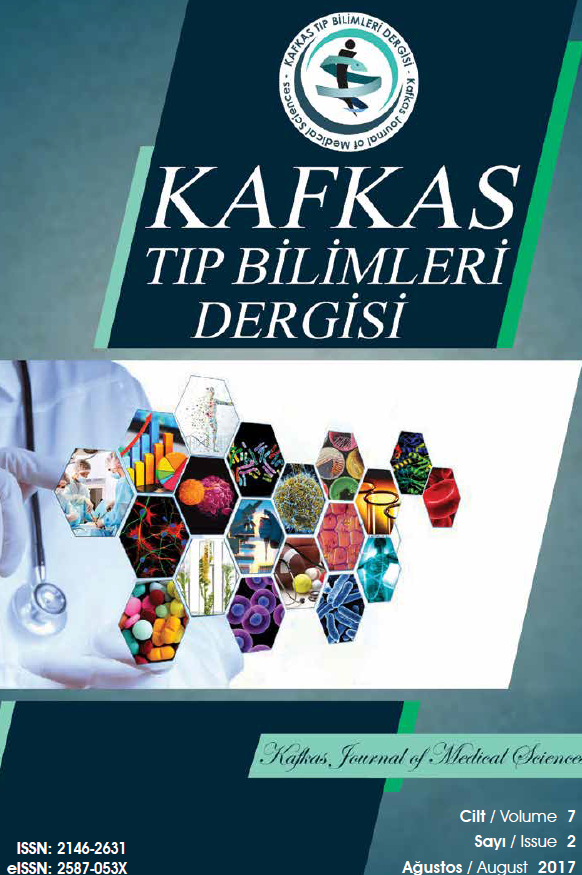Evaluation of Penetrating Keratoplasty Results: Initial Experiences
Evaluation of Penetrating Keratoplasty Results: Initial Experiences
penetrating keratoplasty, indications;, complications,
___
- 1. Whitcher JP, Srinivasan M, Upadhyay P. Corneal blindness a global perspective. Bull World Health Org. 2001;79(3):21421.
- 2. Çubuk M, Koçluk Y, Özelbaykal B. Indication distributions and clinical results in penetrating keratoplasy cases. Turkiye Klinikleri J Ophthalmol. 2019;28(4):273–80
- 3. Matthaei M, Sandhaeger H, Hermel M, Adler W, Jun AS, Cursiefen C, et al. Changing Indications in Penetrating Keratoplasty: A Systematic Review of 34 Years of Global Reporting. Transplantation. 2017;101(6):1387–99.
- 4. Niederkorn JY. The immune privilege of corneal grafts. J Leukoc Biol. 2003;74(2):167–71.
- 5. Stechschulte SU, Azar DT. Complications after penetrating keratoplasty. Int Ophthalmol Clin. 2000;40(1):27–43.
- 6. Öndaş O, Keleş S, Bozkurt E. Aetiology, Outcomes And Prognosis Of Penetrating Keratoplasty Performed On Patients Aged Above 65 Years. Turkish Journal of Geriatrics. 2019; 22(1): 56–65.
- 7. Arıkan G, Durak İ, Yaman A, Özbek Z. Penetrating keratoplasty in children. Türk Oftalmoloji Gazetesi 2006;36:197–202.
- 8. Bayden Ö, Torun Acar B, Acar S. Pediatric Keratoplasty Indications and Outcomes. MN Ophthalmol 2012;19(2):818.
- 9. Tanyıldız B, Goktaş E, Tutaş Gunaydın N, Kandemir B. Clinical Findings and Visual Outcomes of Patients Who Underwent Urgent Keratoplasty. MN Ophthalmol 2020;27(2):75–80.
- 10. Nurözler AB, Özkan G, Onat M, Budak K, Örnek F. The Results of Tectonic Keratoplasty. MN Ophthalmol 2008;15(3):15762.
- 11. Abdelaal AM, Alqassimi AH, Malak M, Hijazi HT, Hadrawi M, Khan MA. Indications of Keratoplasty and Outcomes of Deep Anterior Lamellar Keratoplasty Compared to Penetrating Keratoplasty. Cureus. 2021;13(3):e13825.
- 12. Dasar L, Pujar C, Gill KS, Patil M, Salagar M. Indications of penetrating keratoplasty in southern India. J Clin Diagn Res. 2013 Nov;7(11):2505–7.
- 13. Zhang AQ, Rubenstein D, Price AJ, Côté E, Levitt M, Sharpen L, et al. Evolving surgical techniques of and indications for corneal transplantation in Ontario: 2000 – 2012. Can J Ophthalmol. 2013;48(3):153–9.
- 14. Koppen C, Kreps EO, Anthonissen L, Van Hoey M, Dhubhghaill SN, Vermeulen L. Scleral Lenses Reduce the Need for Corneal Transplants in Severe Keratoconus. Am J Ophthalmol. 2018;185:43–7.
- 15. Anshu A, Price MO, Price FW Jr. Risk of corneal transplant rejection significantly reduced with Descemet’s membrane endothelial keratoplasty. Ophthalmology. 2012;119(3):53640.
- 16. Yildiz EH, Hoskins E, Fram N, Rapuano CJ, Hammersmith KM, Laibson PR, et al. Third or greater penetrating keratoplasties: indications, survival, and visual outcomes. Cornea. 2010;29(3):254–9.
- 17. Altay Y, Burcu A, Aksoy G, Ozdemir ES, Ornek F. Changing indications and techniques for corneal transplantations at a tertiary referral center in Turkey, from 1995 to 2014. Clin Ophthalmol. 2016;10:1007–13.
- 18. Muhafiz E. Advances in Non-surgical Treatment Methods in Vision Rehabilitation of Keratoconus Patients. In: Ziaei A, Lanza M, ed. Eyesight and Imaging – Advances and New Perspectives [Internet]. London: IntechOpen; 2021.
- 19. Akyol F, Küçökgül S, Bayata A, Akkaya A, Çakmaklı Z. Penetrating keratoplasty results in İzmir Atatürk State Hospital. T Klin J Ophthalmol 1996;5:312–319.
- 20. Boisjoly HM, Bernard PM, Dubé I, Laughrea PA, Bazin R, Bernier J. Effect of factors unrelated to tissue matching on comeal transplant endothelial rejection. Am J Ophthalmol. 1989;107(6):647–54.
- 21. Thompson RW Jr, Price MO, Bowers PJ, Price FW Jr. Long-term graft survival after penetrating keratoplasty. Ophthalmology. 2003;110(7):1396–402.
- 22. Muraine M, Sanchez C, Watt L, Retout A, Brasseur G. Long-term results of penetrating keratoplasty. A 10-yearplus retrospective study. Graefes Arch Clin Exp Ophthalmol. 2003;241(7):571–6.
- ISSN: 2146-2631
- Yayın Aralığı: Yılda 3 Sayı
- Başlangıç: 2011
- Yayıncı: Kafkas Üniversitesi
The Cognitive Benefits of Playing Volleyball: A Systematic Review
Evrim GÖKÇE, Emel GUNES, Erhan NALÇACI
Evaluation of the Relationship Between Mitral Annular Calcification and CRP/albumin Ratio
Kürşat AKBUĞA, Hatice KAYIKCIOĞLU
Evaluation of Penetrating Keratoplasty Results: Initial Experiences
Mehmet Siraç DEMİR, Ersin MUHAFİZ, Yusuf EVCİMEN
The Role of Endosonography in Patients With Moderate and High Probability of Choledocholithiasis
Rasim Eren CANKURTARAN, Zahide ŞİMŞEK, Yusuf COŞKUN
Does Subclinical Hypothyroidism Alter the Axis of QRS and P Waves?
Timor OMAR, Metin ÇAĞDAŞ, Mahmut YESİN, Doğan ILİS, Muammer KARAKAYALI, İnanc ARTAC, Mustafa AVCI, Hikmet Utku ODMAN, Yavuz KARABAĞ, Ibrahim RENCÜZOĞULLARI
Past to Present, Epidemiology of SARS-CoV-2 Infection and Ways of Treatment: A Review
